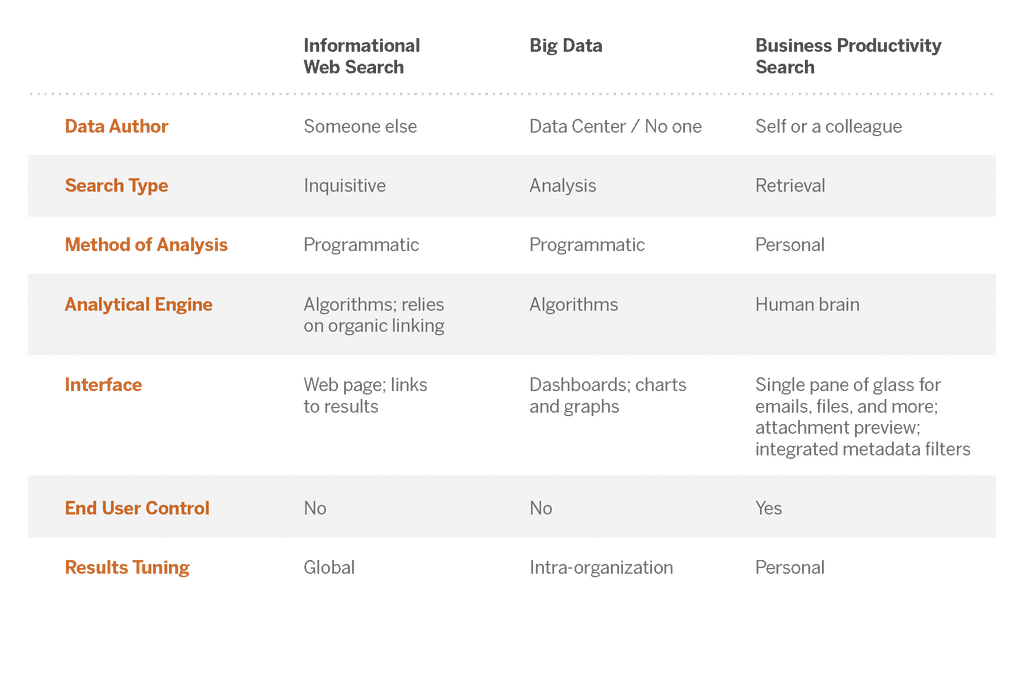Last weeks’ guest blog post by Office 365 expert and independent consultant Bruce Berls clearly outlined why Windows search effectively does not work for business productivity search. Berls, from his testing, noted “I can’t find any OneDrive files when I do a search in Windows” and that any search results were “wildly inconsistent.”
Berls points out that “Microsoft has a vision of grand unified searches that return results from your own files and email, plus results from a wide variety of other places – the web, company documents, other people’s calendars, the contents of books you intend to read but haven’t gotten to yet, your senior thesis…Basically when you do a search, Microsoft will check the entire output of Western civilization and use smart AI to show you search results that are exactly what you want, whether you want them or not.”
And therein lies the problem.
In addition to being very buggy and slow, Microsoft has misapplied big data analytics to try and address business productivity search. That is a major mistake. Big data AI tools can deliver some useful business intelligence to those who are managing structured processes, and every major company has deployed some kind of AI process. But every company still has the problem of business workers not being able to find their information for productivity purposes. That is because the human brain is the most powerful analytical engine for business productivity search, and most search solutions do not effectively leverage this power. Windows O365 utilizes algorithms that try to predict things like document taxonomy classifications. That can be useful for specific use cases, but not to enable business productively search, because AI-based search results are largely a cacophony of mostly unwanted information and “insights” that only frustrates the user.
When a knowledge professional performs a business productivity search, they generally have an idea of what they are looking for. They may be searching for a sales proposal from two years ago, a PowerPoint discussing GDPR compliance, or an email sent to the CFO last month with a proposed budget in a spreadsheet attachment. For these very common, in fact hourly, use cases, a search solution with a user-friendly interface that allows humans to use their institutional business memory recall to iteratively search and filter through their information assets is needed. Business productivity search is not big data analytics and it is not web retrieval. It is its own use case with a workflow and interface that is tailored to the end users.
X1 Search provides the end-user with a powerful yet user-friendly and iterative means to quickly retrieve their business documents and emails using their own memory recall as opposed to generic algorithms that generate false positives and a workflow ill-suited to business productivity search. This analysis is crystalized in the accompanying chart differentiating X1’s approach to business productivity search versus big data analytics and web search.
These points are further mentioned in this testimonial from recent Nobel Prize Winner in Chemistry and Stanford professor Dr. Michael Levitt, who states: “X1 is an intimate part of my workflow — it is essentially an extension of my mind when I engage in information retrieval, which is many times an hour during my workday.” In my opinion, you will not find that level of enthusiasm by end-users for other enterprise search platforms.
Given these requirements, X1 emerges as the best choice for a business productivity search solution. The X1 Search interface is award-winning and beloved by users (try finding users that love traditional enterprise search). Business professionals can search emails, files, OneDrive SharePoint, and the other content, whether local or in Office 365, that they need to do their jobs in a single-pane-of-glass interface that enables post-search actions. Directly in the UI, users can respond to emails, for example, or forward OneDrive documents. With this kind of user interface, business workers can use their business memory recall and intuition to quickly find information. They can instantaneously filter and preview directly in the UI, providing an iterative search process, making it possible to find that critical document in a matter of seconds. And you can try X1 Search via a free trial.
